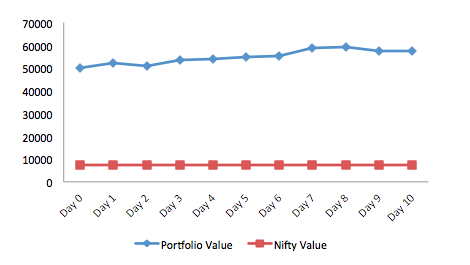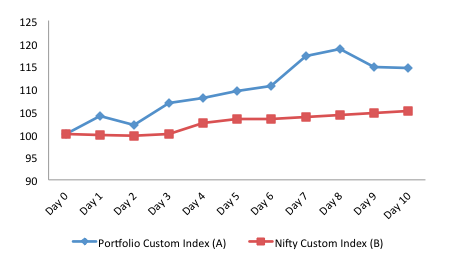To understand the basics of benchmarking, please refer our article on the same here. The following article is written assuming that you have read this article. Once we have created our portfolio, the next step is to define a benchmark for the same. A good benchmark should have similar risk and return characteristics to our portfolio.
For the banking sector example which we have been using throughout this series, Bank Nifty would be a good Benchmark. Bank NIFTY is an index on National Stock Exchange of India comprising of the big banks in India. The index will also benefit from the recapitalization decision of government, which formed the basis of us creating this PSU banks portfolio. At the same time, the index faces the same set of risks faced by all banking stocks. We say this because the risks like rising interest rates and low loan demand are same for stocks in our portfolio, as well as stocks in Bank NIFTY.
Now, suppose in a period of 3 months, our portfolio generates a return of 10%. Generally, we would be very happy to know this. But if we get to know that Bank NIFTY generated a return of 15%, in the same time period, then what? In this case, our portfolio underperformed the benchmark by 5%. This means that our stock selection was not good, as the general sector (represented by Bank NIFTY) outperformed our portfolio. In an opposite case, if our portfolio generates a return of 18%, then we can confidently say that our stock selection was superior, as through our selection of banking stocks based on some criteria, we outperformed the broader banking sector. Thus, it is very important to use right benchmark in order to determine whether we are able to outperform the broader market through our stock selection.
Instead of banking stocks, if our portfolio had IT stocks, then CNX NIFTY IT would be a better Benchmark. Similarly, for Auto sector companies, CNX Auto will be a better benchmark. If our portfolio comprises of stocks from different sectors, then we can use Nifty as a benchmark. This would tell us whether we are able to beat the market through our portfolio selection or not.
Similar to our portfolio, we can create a custom index for benchmark also. Index creation process is exactly same for the benchmark and the portfolio. Assuming NIFTY as benchmark, below table summarizes the index values at different dates.
| Day | Portfolio Value | Portfolio Custom Index (A) | NIFTY Value | NIFTY Custom Index (B) | Outperformance (= A - B) |
|---|---|---|---|---|---|
| Day 0 | 50,056.15 | 100.00 | 7213.60 | 100.00 | 0.00 |
| Day 1 | 52,108.65 | 104.10 | 7210.75 | 99.96 | 4.14 |
| Day 2 | 51,105.87 | 102.10 | 7191.75 | 99.70 | 2.40 |
| Day 3 | 53,500.12 | 106.88 | 7218.45 | 100.07 | 6.81 |
| Day 4 | 54,100.11 | 108.08 | 7400.15 | 102.59 | 5.49 |
| Day 5 | 54,800.14 | 109.48 | 7450.85 | 103.29 | 6.19 |
| Day 6 | 55,321.15 | 110.52 | 7455.74 | 103.36 | 7.16 |
| Day 7 | 58,659.75 | 117.19 | 7480.25 | 103.70 | 13.49 |
| Day 8 | 59,457.87 | 118.78 | 7515.64 | 104.19 | 14.60 |
| Day 9 | 57,458.78 | 114.79 | 7555.55 | 104.74 | 10.05 |
| Day 10 | 57,300.12 | 114.47 | 7590.24 | 105.22 | 9.25 |
If we observe that on Day 9 the value of our portfolio is 57300.12 and the value of the NIFTY is 7590.24, its very difficult to conclude anything. But instead, if we are told that the index value of the portfolio is 114.79 and index value for NIFTY is 104.75, we can quickly conclude following things without any calculations:
- Portfolio has generated a return of 14.79%
- NIFTY has generated a return of 4.75% in the same period
- Portfolio has outperformed NIFTY by around 10%
In addition to above points, custom indices also helps in plotting meaningful graphs. In the first graph we have directly plotted the values of portfolio and NIFTY. In second graph, we have plotted index values of portfolio and NIFTY.


By looking at the first graph, we can’t say anything. But with the second graph, we can comfortably conclude how our portfolio has been performing, compared to Nifty. We can easily find out how our portfolio was performing to Nifty, on historical dates also.
Now we know the importance of benchmarking and custom indices and their role in making portfolio tracking simple, easy and efficient.








Add a comment